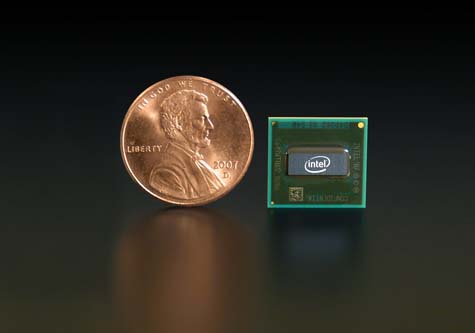Ready or not, here comes Silverthorne

At the International Solid-State Circuits Conference in San Francisco this week, Intel revealed details of its new low-power processor, which promises to deliver performance similar to a low-end laptop in a package that uses only a bit more power than a smartphone. The design is innovative--and significant since it marks the start of a new effort by Intel (remember XScale?) to conquer the handheld world. But does the world really want Silverthorne-based Ultra-Mobile PCs (UMPCs) and Mobile Internet Devices (MIDs)?
Silverthorne is hardly a new name. Intel first talked up the chip at the Intel Developer Forum in Beijing last spring. And at CES earlier this year, it showed prototypes of UMPCs and MIDs from 15 different companies all based on Menlow, the new platform that includes both the Silverthorne processor and a chipset named Poulsbo. But this is the first time they've discussed the new microarchitecture in detail.
Intel manufactures Silverthorne using 45nm process technology with a high-k dielectric (a high-resistance insulator based on hafnium rather than the usual silicon dioxide) and metal gates. This is the same technology used in the new Penryn desktop and laptop chips. (Since introducing it last November, Intel has already shipped 32 Penryns for desktops, laptops, servers and workstations.) Silverthorne consists of 47 million transistors on a die that measures only 24.2 square millimeters. To put that in perspective, the dual-core Penryn measures 107 square millimeters. You need a small chip to build an ultra-mobile gadget, of course. But it also makes Silverthorne cheaper to manufacture since Intel can fit thousands of chips on a single silicon wafer.
Though it can reach speeds of 2.5GHz, Silverthorne will likely be available at clock speeds between 1.5GHz and 2.0GHz with a TDP ranging from 0.6 to 2 watts. This is peak power, and Intel was quick to point out that the power consumption under more typical usage and during idle time will actually be much lower--measured in "hundreds of milliwatts." The ultra low voltage versions of the Core 2 Duo, such as the U7700, have a TDP of 10W, but a more accurate comparison is McCaslin, the current platform for UMPCs that uses Intel A100 and A110 chips with a TDP of 3W.
There are two notable aspects of this new design. It is the first Intel processor with an in-order pipeline since the days of Pentium "classic." Starting with the introduction of the P6 (aka Pentium Pro) in 1995, most chips have used an out-of-order pipeline that dynamically reorders program instructions to speed up execution. Intel says a 14-stage, in-order pipeline with multithreading gives the 64-bit Silverthorne the best combination of performance and low power consumption. The other new feature is a Deep Power Down mode, also known as C6, which essentially turns off nearly all system components and stores the processor state in an on-die SRAM. It takes a bit longer for the device to get into and out of C6--about 100 milliseconds--but depending on the usage, Intel says Silverthorne can spend up to 90% of its time in deep sleep resulting in significant power savings. There are other, more minor, power tweaks in the register files, cache and ROM.
It's tough to gauge just how effective all this will be since Intel has yet to give absolute numbers on either performance or battery life. What is clear is that despite significant progress Silverthorne still runs too hot to go head-to-head with the ARM-based processors found in most smartphones. And given that the circuit board measures 74mm x 143mm--larger than an iPhone--Menlow is really only suited for the larger MIDs and UMPCs like the HTC Shift.
Intel has been touting Silverthorne's compatibility with the x86 instruction set architecture (ISA), and this should be a competitive advantage because it makes it relatively easy to tweak existing PC applications to run on ultramobile gadgets. For example, MIDs and UMPCs can run Adobe Flash. But this won’t be enough to convince many people to carry a second or third mobile device, which is why Menlow seems like a stopgap. Things should get more interesting in 2009-2010 when we get its replacement, Moorestown. Intel has hinted that the processor for the Moorestown platform will be more of a SoC (System-on-a-Chip) design with not only a 45nm core, but also a memory controller, graphics and video encoding and decoding. That would position Intel to compete directly with Qualcomm and TI--both of which are already working on 45nm SoCs--for smartphones.
